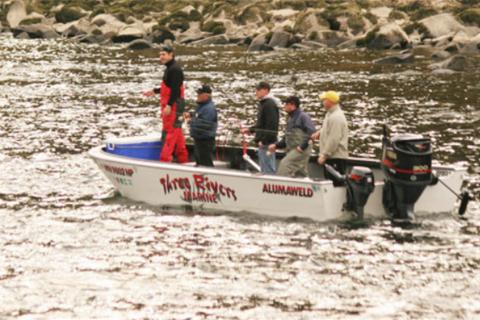
By Scott Haugen, Cabela’s Ambassador
Side-drifting is arguably the most effective technique when it comes to fishing for winter steelhead in rivers and it is one of the best ways to cover large amounts of water from a boat.
The natural rate of presentation entices fish to bite a high percentage of the time when compared to other techniques.
Gearing up For Side-Drifting Starts With the Proper Fishing Rod
My fishing rod of choice is a super-high modulus graphite rod that is a 9-feet, 2-inches long and rated for 6- to 10-pound-test line, and lures weighing one-quarter to one-half ounce, with a moderate action and medium-light weight.
Pair the rod with appropriate line and leader to meet the fishing conditions, then focus on the terminal gear.
I’ve fished a wide array of side-drifting presentations over the years, from double-hook bait setups topped with a drift-bobber to bare eggs on a small single hook. Single eggs work well, and beads, Lil’ Corkies and rubber egg clusters, along with yarn balls and rags, all are good side-drifting baits.
My favorite presentation in clear water conditions is a size 1 octopus-style hook with no more than four or five cured eggs, in a cluster, placed in the egg loop. Run a short, two-to-three-inch dropper and attach a weight that is light enough to occasionally tick the bottom during the drift.
Avoid too much weight, which results in dragging, not allowing the bait to be channeled by natural currents into food funnels. In very low conditions, a larger bait with no weight can even be effective.
Thread on a bait-floater, barely exposing the tip of the hook to keep the hook’s point aimed upward, decreasing the chance of it hanging up during a drift.
Have multiple rods rigged and ready to go, along with pre-cut baits and pre-tied leaders, in case the terminal gear is lost while drifting through a section of prime water. Lots of times rivers are flowing too quickly to row back upstream to fish, and you don’t want to miss that prime holding water.
All anglers in the boat should simultaneously cast slightly upstream of the boat, parallel to one another.
The oarsman or motor operator takes over from there, positioning and timing the rate at which the boat moves downstream to that of the lines on the surface and terminal gear.
Bites when side-drifting are often slow to develop, so avoid the tendency to immediately jerk every time you see or feel something, so you don’t yank the terminal gear out of the strike zone.
After you try side-drifting, you’ll see why it’s ranked as one of the most effective ways to catch winter steelhead.
- 3379 views

